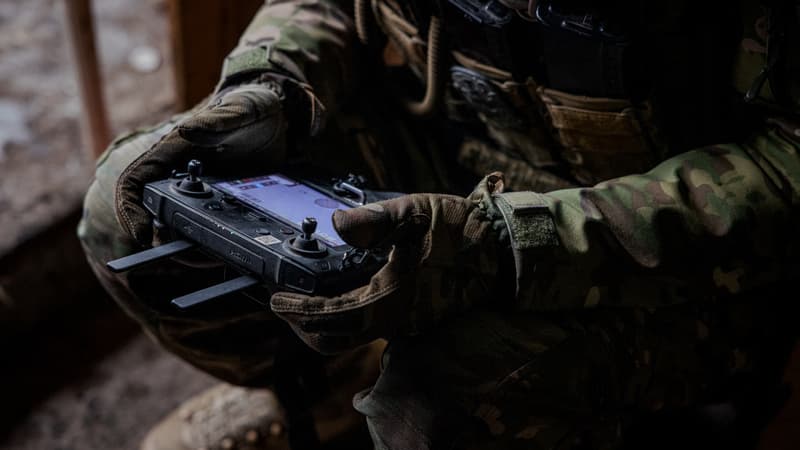“We are facing two technological powers”, warns Alice Pannier, researcher and head of the Geopolitics of Technologies program at Ifri. The war in Ukraine is above all a hybrid war, the technological stakes being just as important as the territorial stakes.
In the spring, China could supply Russia with suicide drones. By April, Moscow should receive 100 drones of the ZT-180 type, capable of carrying an explosive charge of 35 to 50 kilograms. Not inconsiderable support for Russia since drones have become a true weapon of war, which allows you to take advantage of your opponent.
However, the use of drones is not new in the conflict between the two countries. “Already in 2014, in the Donbass region, Ukraine used drones, in particular for reconnaissance operations,” the researcher stresses. The country has even created a specialized unit with more than 2000 soldiers trained to fly these machines.
To multiply the blows and wear down their opponent, Ukraine redoubles their inventiveness. The military uses commercial drones of the Chinese brand DJI to transform them into kamikaze machines, attaching anti-armor grenades to them. This system allows soldiers to be more discreet and precise in reaching their target, especially in urban areas. After a reconnaissance mission, drones drop on the target, causing several explosions.
The influence of technology companies
In Ukraine, drones operate over SpaceX’s Starlink network, which provides an Internet connection to keep the country connected. Starlink is a satellite internet access system that has become an indispensable tool for the country. Except that in early February, Elon Musk’s company asked Kiev to no longer use its networks to control combat drones., Not for military purposes.
Since the start of the war, Starlink has supplied approximately 25,000 kits to Ukraine, which have beensubstantial support for the army. Elon Musk has a delicate position in this conflict. Owner of Starlink but also of Twitter, he has significant influence. And his frequent positions, often highly criticized, are not trivial.
For example, Microsoft provided a data backup system for the Ukrainian administration by transferring its servers to its cloud. A useful digital solution in case of a cyberattack, of which there were many during this first year of war. Ukraine reportedly counted 4,500 who attacked it, including 25% targeting the government, 13% the energy sector, 12% finance and 10% the media, according to the report. Microsoft Advocacy Digital Report 2022.
Hours before the start of the war, on February 24, 2022, Russia targeted Ukraine’s KA-SAT satellite network, causing Viasat, a major satellite telecommunications player, to be disrupted in the country.
two digital powers
However, Ukraine has a recognized digital defense, having faced numerous Russian cyberattacks. From the beginning of the war, the country understood the importance of strengthening this defense.
The Minister of Digital, Mykhailo Fedorov, then launched an appeal to the population. Anyone with computer skills is then invited to participate in the effort. This is how the IT Army of Ukraine was created, with the aim of destabilizing Russian digital networks.
Ukraine also uses an app called Dïïa. Initially designed to dematerialize official documents, it is now used to share information about the positions of Russian soldiers. The Ukrainian army has also developed an application that allows the population to notify the army in the event of the presence of military vehicles in the area.
For its part, Russia is very well organized. His entire digital army operates on networks, close to the Kremlin. Each entity has a well-defined mission. Among the best known is Gamaredon, suspected of being linked to the Russian secret services. The group has been responsible for hundreds of cyberattacks targeting public or private actors in Ukraine for nearly a decade.
The responsibility of social networks
But Russia has also suffered from cyberattacks. On May 9, 2022, the Russian site RuTube went offline and it took three days to restart. On the same day, Russian television was also attacked for broadcasting anti-war messages.
“The information war has a central place in the influence strategy of the two countries,” analyzes the Ifri researcher. And the platforms are at the forefront of spreading misinformation. Starting with Twitter. Twitter Blue paid option launched by Elon Musk particularly benefits Russian accounts, who gain visibility and thus massively disseminate national propaganda.
The platforms try to contain this misinformation, even if it is timid. TikTok said dismantle a Russian disinformation network targeting European Internet users. A total of 1,700 accounts were identified.
In May 2022, ANDouTube claimed to have removed 70,000 videos and 9,000 channels related to war disinformation. As for Facebook,The social network dismantled a Russian network end of september. At the heart of the operation were around 60 websites imitating well-known media sites, including German newspapers. spiegel AND Imagethe english newspaper The Guardian or the Italian agency ANSA.
In the coming years, cyber warfare will be a central issue in future conflicts. “Civilian infrastructures are increasingly connected and contain information of interest to the adversary. This hyperconnection will increase what is called the plausible attack surface,” predicts Alice Pannier.
Source: BFM TV


